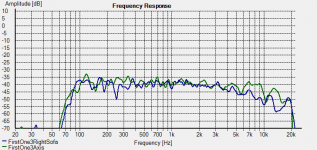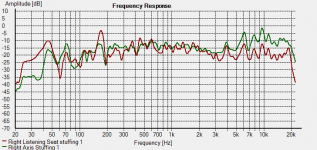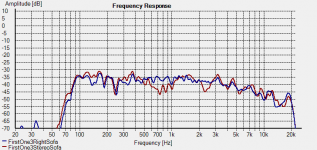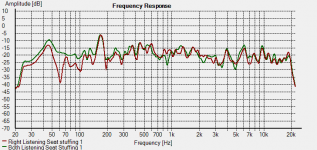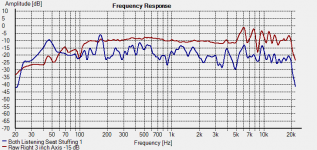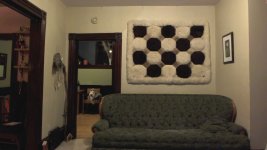I could not hear much (any?) difference probably due to reflections in a small room.
Another thing to consider is that it's hard to compare full tracks due to "blanking" effect in between. Shorter samples with the most pronounced parts might work better, though the best approach is having both tracks in sync with an ability to switch between two instantly during playback.
Another thing to consider is that it's hard to compare full tracks due to "blanking" effect in between. Shorter samples with the most pronounced parts might work better, though the best approach is having both tracks in sync with an ability to switch between two instantly during playback.
Thanks for the samples!
I preferred 'A' a as the more natural voice.
This was a subtle difference, but it seemed more natural and distinct. Considering my substandard and unbalanced hearing, I didn't expect to have a preference. I will setup for an ABX test to see if my difference is real or imagined. Just wanted to comment before the reveal.
I appreciate all your efforts in sharing your experiences. I find all your comments to be well thought out.
I preferred 'A' a as the more natural voice.
This was a subtle difference, but it seemed more natural and distinct. Considering my substandard and unbalanced hearing, I didn't expect to have a preference. I will setup for an ABX test to see if my difference is real or imagined. Just wanted to comment before the reveal.
I appreciate all your efforts in sharing your experiences. I find all your comments to be well thought out.
So, I did play it on my system and room that has bass traps, but no panels on the concrete walls and ceiling, with hardwood floor. And I still stand by what I said earlier.
On my system, there was a tonality change. A was warmer, but fuzzier, B was more precise, sizzle of cymbals were more discernible, but overall sounded artificial to my ears.
My 2 cents....
On my system, there was a tonality change. A was warmer, but fuzzier, B was more precise, sizzle of cymbals were more discernible, but overall sounded artificial to my ears.
My 2 cents....
I will setup for an ABX test to see if my difference is real or imagined
Update: The ABX test indicated that my imagination is better than my hearing. I scored 10/20 so I can't tell a difference between the files.
It's not surprising. This is why I usually avoid commenting on perceived subtle differences.
It's Friday somewhere  ....
....
The reveal of what was done:
Track Camilio-A has been treated with the Rephase Shuffle-2.wav impulse. Altering its phase only, frequency response remaining unaltered.
Track Camilio-B was unaltered as found on my CD (Fidelio 2009). To be fair to track A it has been trough JRiver's 'write to disk' output then converted to flac.
My own prior conclusion still stands. For me the phase shuffle has a side effect as it alters tonal balance. Slight differences occur in placement of the stage, which was it's original intend. Before using my own home brew cross talk DSP I liked certain parts of the staging changes with the shuffler, but could not cure what I experienced as a fault in the tonal balance.
This time around, with the cross talk (and a restored ambient setup) the differences in staging are small if any.
Yet I do still hear tonal differences (anomalies really) that I don't like. It's not huge differences by the way. Just some parts in the upper end stand out more.
This can be different from person to person and from room to room. It (the shuffler) was meant to combat/alter cross talk at the ears from the left speaker bleed to the right ear and vice versa. As such it does do something and it certainly is different from the original recording. But different isn't always better.
I usually like to try some things a second time, to find out if my original judgement was justified. I think I can let go of the idea of the shuffler being beneficial in/for my setup. I tested way more tracks to come to my conclusion but thought it would be fun to hear from others.
The reveal of what was done:
Track Camilio-A has been treated with the Rephase Shuffle-2.wav impulse. Altering its phase only, frequency response remaining unaltered.
Track Camilio-B was unaltered as found on my CD (Fidelio 2009). To be fair to track A it has been trough JRiver's 'write to disk' output then converted to flac.
My own prior conclusion still stands. For me the phase shuffle has a side effect as it alters tonal balance. Slight differences occur in placement of the stage, which was it's original intend. Before using my own home brew cross talk DSP I liked certain parts of the staging changes with the shuffler, but could not cure what I experienced as a fault in the tonal balance.
This time around, with the cross talk (and a restored ambient setup) the differences in staging are small if any.
Yet I do still hear tonal differences (anomalies really) that I don't like. It's not huge differences by the way. Just some parts in the upper end stand out more.
This can be different from person to person and from room to room. It (the shuffler) was meant to combat/alter cross talk at the ears from the left speaker bleed to the right ear and vice versa. As such it does do something and it certainly is different from the original recording. But different isn't always better.
I usually like to try some things a second time, to find out if my original judgement was justified. I think I can let go of the idea of the shuffler being beneficial in/for my setup. I tested way more tracks to come to my conclusion but thought it would be fun to hear from others.
Last edited:
Camillio after a 13 hour day with Avebury...
The last post I read on this thread was:
I figured I had better try this again before I knew the answer.
I wanted to see if I would have the same impressions after a long day/night of work and thru a true point source system verses a line array...
Surprisingly enough, I still prefer track B. And overall my perception is the same:
Track B is clearer, more realistic and projects more in front of the speakers.
Track A is more blended, warmer and behind the speakers. The width of the sound stage is the same with both tracks, but I perceive more "forward" depth with Track B.
I would still say I "perceive" more mid-bass in track A. Thru my EQing adventures, I have observed that I do indeed perceive more mid-bass depending on the amount of taps I use, and whether the filters are minimum phase or linear phase, even though the frequency response measures the same. This is a very interesting puzzle for me, one I am still working to figure out.
I am really glad I set up my Avebury system and tried this, it is the first time I heard the Avebury thru my Buffalo DAC with the First One Amp, and I have to say, this is the first time I have really heard these speakers. Very likable indeed. It is nice to enjoy music without feeling the need to tweak (although, I do have some tweaks in mind
Very likable indeed. It is nice to enjoy music without feeling the need to tweak (although, I do have some tweaks in mind  ). My system upgrades have definitely brought these speakers back to life.
). My system upgrades have definitely brought these speakers back to life.
Now, I will read the posts above this one, and see if Ronald has revealed which is which.
The last post I read on this thread was:
Shall I reveal which track has been shuffled?
I figured I had better try this again before I knew the answer.
I wanted to see if I would have the same impressions after a long day/night of work and thru a true point source system verses a line array...
Surprisingly enough, I still prefer track B. And overall my perception is the same:
Track B is clearer, more realistic and projects more in front of the speakers.
Track A is more blended, warmer and behind the speakers. The width of the sound stage is the same with both tracks, but I perceive more "forward" depth with Track B.
I would still say I "perceive" more mid-bass in track A. Thru my EQing adventures, I have observed that I do indeed perceive more mid-bass depending on the amount of taps I use, and whether the filters are minimum phase or linear phase, even though the frequency response measures the same. This is a very interesting puzzle for me, one I am still working to figure out.
I am really glad I set up my Avebury system and tried this, it is the first time I heard the Avebury thru my Buffalo DAC with the First One Amp, and I have to say, this is the first time I have really heard these speakers.
Now, I will read the posts above this one, and see if Ronald has revealed which is which.
Wow, now that is interesting. I figured track B was the altered one.  It is good to know that I prefer the original recording! Just goes to show, sometimes less is more!
It is good to know that I prefer the original recording! Just goes to show, sometimes less is more!
This also shed some light on my "more" issue with the arrays, now knowing that it is an array issue. Redoing this test with Avebury also helped validate this.
Thanks for the test, Ronald. I can forego the phase shuffler.
This also shed some light on my "more" issue with the arrays, now knowing that it is an array issue. Redoing this test with Avebury also helped validate this.
Thanks for the test, Ronald. I can forego the phase shuffler.
As the mid-bass is outside of the phase edit in these two tracks it must be a tonal balance issue. Tonal balance is determined over a longer listening period, including room reflections within the perception. With these little timing differences you could experience a slightly different summing at the ear. (the actual goal of the shuffler)
Any room reflection that is present will also alter what you experience as tonal balance.
Believe me, most of us like to have some reflections. (that close by wall behind you is doing something)
I 'stole' the reflections out of the room with damping panels, only to replace them by (FR) controllable late reflections (ambient channels) to make up for it.
Any room reflection that is present will also alter what you experience as tonal balance.
Believe me, most of us like to have some reflections. (that close by wall behind you is doing something)
I 'stole' the reflections out of the room with damping panels, only to replace them by (FR) controllable late reflections (ambient channels) to make up for it.
Back wall reflections...
Back Wall influences: I would say.
Here are the one axis and listening seat measurements for the right channel of both systems. The EQ settings shown here for the arrays are an older setting, but You can see what the room is doing. (I can not find my newer settings ). The Avebury is un-EQed at the moment. The horns are putting out too much above 100 Hz. I have heard I can tame this by stuffing the horns, so I am experimenting with that. First attempt did show some improvements, but as You can see, still an unacceptable peak around 180 Hz. I am not as worried about the peak around 40 hz, as I can do a simple high pass to tame that and protect the speakers from the 10 Hz sub-sonic stuff on blu-rays.
). The Avebury is un-EQed at the moment. The horns are putting out too much above 100 Hz. I have heard I can tame this by stuffing the horns, so I am experimenting with that. First attempt did show some improvements, but as You can see, still an unacceptable peak around 180 Hz. I am not as worried about the peak around 40 hz, as I can do a simple high pass to tame that and protect the speakers from the 10 Hz sub-sonic stuff on blu-rays.
I do need to address my back wall. Yet, I am sure once I do, I too will want to add some rear speakers. Will need to build a second Buffalo DAC and procure a way to get the four channels to them - a whole new adventure in itself.
Ronald, what material are your damping panels and what frequencies have You found they affect?
Back Wall influences: I would say.
Here are the one axis and listening seat measurements for the right channel of both systems. The EQ settings shown here for the arrays are an older setting, but You can see what the room is doing. (I can not find my newer settings
I do need to address my back wall. Yet, I am sure once I do, I too will want to add some rear speakers. Will need to build a second Buffalo DAC and procure a way to get the four channels to them - a whole new adventure in itself.
Ronald, what material are your damping panels and what frequencies have You found they affect?
Attachments
I used fiberglass insulation panels for home insulation, mounted slightly from the back wall so each reflection travels twice trough the panel and air gap. I was looking to tame the mid frequencies: here's a before/after plot:

I'd say it did something... (two very different curves were chosen)
(two very different curves were chosen)

I'd say it did something...
Stereo speakers and wall interactions...
As we are on the topic of how two stereo speakers interact with each other, here are the measurements of how the back wall and each of the speakers interact with each other at the listening seat - not a pretty picture for the arrays at all (first graph).
Oddly enough, the Avebury fairs a little better here (second graph). Maybe being a point source, there is less interaction.
Here is the real question: Is it the back wall causing the most harm, or is it the interaction between the stereo channels? Obviously, both are at fault, but which one is the biggest culprit?
I should note, that the Axis measurements in the previous post were taken three feet in front of the speakers, my listening seat being seven feet back and 30 degrees off axis.
My goal for posting these measurements is, if I do indeed find ways to improve this, maybe we all can learn something.
As we are on the topic of how two stereo speakers interact with each other, here are the measurements of how the back wall and each of the speakers interact with each other at the listening seat - not a pretty picture for the arrays at all (first graph).
Oddly enough, the Avebury fairs a little better here (second graph). Maybe being a point source, there is less interaction.
Here is the real question: Is it the back wall causing the most harm, or is it the interaction between the stereo channels? Obviously, both are at fault, but which one is the biggest culprit?
I should note, that the Axis measurements in the previous post were taken three feet in front of the speakers, my listening seat being seven feet back and 30 degrees off axis.
My goal for posting these measurements is, if I do indeed find ways to improve this, maybe we all can learn something.
Attachments
Last edited:
Thanks, Ronald
How thick is the insulation and how far from the wall?
Which curve is which? I like the "smoothness" (less peaks and dips) of the blue curve, I am guessing that is with the treatments.
For laughs and giggles, here is a comparison between the the Right Avebury measured 3 inches away from the driver to both speakers at the listening seat. That is quite a change to say the least.
Room is a big part, yet I am also thinking cabinet shapes could improve things here also.
I used fiberglass insulation panels for home insulation, mounted slightly from the back wall so each reflection travels twice trough the panel and air gap. I was looking to tame the mid frequencies: here's a before/after plot:
How thick is the insulation and how far from the wall?
I'd say it did something...(two very different curves were chosen)
Which curve is which? I like the "smoothness" (less peaks and dips) of the blue curve, I am guessing that is with the treatments.
For laughs and giggles, here is a comparison between the the Right Avebury measured 3 inches away from the driver to both speakers at the listening seat. That is quite a change to say the least.
Room is a big part, yet I am also thinking cabinet shapes could improve things here also.
Attachments
The smooth curve is after treatment. A different house curve I was trying at the time. That one didn't last long as having the bottom extend to at least 30 Hz and having -3 dB at 17 Hz is way more fun. (can't do that with movies though, it get's scary fast!)
The panel behind me is 5 cm (or about 2 inches). It's 2 cm from the back wall. With the fluffy itchy fiberglass insulation in there, and I almost forgot, also real wool felt one layer on each side. Packed in printed Kona cotton.
My back wall was showing in my IR at 7 ms. To early for my taste but the liveliness it added in big productions was fun.
Imaging got a lot more clear by bringing that reflection down substantially. The liveliness was back after I added the ambient channels. Though I did tone them down somewhat since. Movie production orchestra's deserve a bit more than I'm currently running . They will do just that when playing the movie in 4.0.
. They will do just that when playing the movie in 4.0.
My side panels are thicker (about 3 inches), I didn't dare do this with the only visible panel.
The panel behind me is 5 cm (or about 2 inches). It's 2 cm from the back wall. With the fluffy itchy fiberglass insulation in there, and I almost forgot, also real wool felt one layer on each side. Packed in printed Kona cotton.
My back wall was showing in my IR at 7 ms. To early for my taste but the liveliness it added in big productions was fun.
Imaging got a lot more clear by bringing that reflection down substantially. The liveliness was back after I added the ambient channels. Though I did tone them down somewhat since. Movie production orchestra's deserve a bit more than I'm currently running
My side panels are thicker (about 3 inches), I didn't dare do this with the only visible panel.
Last edited:
The best material I found for absorption panels was a high temperature fiberglass material that is available from McMaster Carr. This material is much higher density than the standard insulation glass for your walls and has better absorption properties. I made wooden frames and covered these with indoor/outdoor carpeting which also increases the absorption. I don't have any graphs to show but this worked real well when we used these at a few Stereophile and CES shows while demonstrating my speakers. It really helped to tame some horrid hotel rooms used for active display rooms. I think I stacked two layers of the 2" insulation material.
McMaster-Carr
This was the thermal insulation type of material.
http://www.mcmaster.com/#fiberglass-insulation/=14lksvp
McMaster-Carr
This was the thermal insulation type of material.
http://www.mcmaster.com/#fiberglass-insulation/=14lksvp
Last edited:
Thanks both Wesayso and Kindhornman...
As an Artist, I find Ronald's Printed cotton panels quite nice. However, I am thinking if I use the rigid stuff, I could do the whole wall.
Is this the stuff?
McMaster-Carr
It comes either foil faced or kraft faced. I am assuming it is faced only on one side. Here are my questions:
What facing do You prefer? (I am assuming the kraft faced)
Does the facing take away from the absorption qualities when laminating two panels together?
Did You try using one 2" panel with an air gap?
Is there any benefit to an air gap with your 4" thick panels?
I am liking this idea. I could do the whole wall, and cover the whole thing with some nice upholstery. Actually, I am mostly there with the rug I already have on that wall. I could do the adjoining side walls too... ...Or would that be getting carried away?
As an Artist, I find Ronald's Printed cotton panels quite nice. However, I am thinking if I use the rigid stuff, I could do the whole wall.
The best material I found for absorption panels was a high temperature fiberglass material that is available from McMaster Carr... ...I think I stacked two layers of the 2" insulation material.
Is this the stuff?
McMaster-Carr
It comes either foil faced or kraft faced. I am assuming it is faced only on one side. Here are my questions:
What facing do You prefer? (I am assuming the kraft faced)
Does the facing take away from the absorption qualities when laminating two panels together?
Did You try using one 2" panel with an air gap?
Is there any benefit to an air gap with your 4" thick panels?
I am liking this idea. I could do the whole wall, and cover the whole thing with some nice upholstery. Actually, I am mostly there with the rug I already have on that wall. I could do the adjoining side walls too... ...Or would that be getting carried away?
Attachments
Glad I checked the link that does not work!
Wow, McMaster-Carr does not link to the page I want. Is this the stuff?
High-Temperature Rigid Fiberglass Insulation
Foil Faced
Temperature Range: Insulation: 0° to 450° F; Facings: 0° to 150° F
Heat Flow Rate (K-Factor) @ 75° F: 0.23
Density: Medium: 3 lbs./cu. ft.; High: 6 lbs./cu. ft.
Color: Insulation: Yellow; Foil Facing: Silver; Kraft Paper Facing: White
Able to insulate in high-heat environments, these rigid sheets also reduce noise transmission. Sheets have vapor-retarding facings on one side. Seal foil-faced joints with FSK tape; seal kraft-paper-faced joints with ASJ tape (both sold separately). Can be used outdoors with metal jacketing. Meets ASTM E84 25/50 for flame and smoke. High-density sheets can withstand heavy use.
Wow, McMaster-Carr does not link to the page I want. Is this the stuff?
High-Temperature Rigid Fiberglass Insulation
Foil Faced
Temperature Range: Insulation: 0° to 450° F; Facings: 0° to 150° F
Heat Flow Rate (K-Factor) @ 75° F: 0.23
Density: Medium: 3 lbs./cu. ft.; High: 6 lbs./cu. ft.
Color: Insulation: Yellow; Foil Facing: Silver; Kraft Paper Facing: White
Able to insulate in high-heat environments, these rigid sheets also reduce noise transmission. Sheets have vapor-retarding facings on one side. Seal foil-faced joints with FSK tape; seal kraft-paper-faced joints with ASJ tape (both sold separately). Can be used outdoors with metal jacketing. Meets ASTM E84 25/50 for flame and smoke. High-density sheets can withstand heavy use.
Yes, there still is benefit to the air gap. I'd test the rigid panels in their ability to absorb higher frequencies.
My (fluffy) insulation material was faced with a fiberglass layer which I removed and as said, both sides are covered with wool felt. The dissimilar materials help reduce the reflections even further.
Just look at the IR to see what happens:

This is the impulse with help of DRC-FIR prior to the damping panel.
Adding the panel to the back wall made it possible to get this:

Scale is somewhat different, believe me, this one is much better.
I could see it in the STEP where the reflections always messed up the STEP shape. Get the reflections down enough and the STEP won't show any additional peaks or change/disrupt its shape.
The impulse is definitely the place to look at to see the benefits. The goal was to get all reflections down to at least -15 dB below the main pulse. That sounds way easier than it is. The standard IR's mainly show high frequency information. One needs to look at filtered IR's to really see what's going on in the room.
My APL room measurement confirms there still are some peaks, but at least they are down by a significant amount.

That's what made my plots baby smooth in the FR. 1/3 Octave smoothing became straight lines etc. Most people would probably think the FIR processing did that. But without the panels in critical places I could not have done that.
I've spend quite a bit of time chasing all mayor reflection points. (while having REW measuring sessions and looking at IR's while moving panels around the living room).

I checked every direction I could think of . I even moved my stereo equipment
. I even moved my stereo equipment
after taking these pictures, all for the greater cause.
There's still some left overs, but like I said many times: I made a promise to my girl not to hang more panels in our living room. And you can only see one of the panels, the Poster. The placement and size is crucial if you don't do an entire wall. It only took me 3 big panels.
My (fluffy) insulation material was faced with a fiberglass layer which I removed and as said, both sides are covered with wool felt. The dissimilar materials help reduce the reflections even further.
Just look at the IR to see what happens:

This is the impulse with help of DRC-FIR prior to the damping panel.
Adding the panel to the back wall made it possible to get this:

Scale is somewhat different, believe me, this one is much better.
I could see it in the STEP where the reflections always messed up the STEP shape. Get the reflections down enough and the STEP won't show any additional peaks or change/disrupt its shape.
The impulse is definitely the place to look at to see the benefits. The goal was to get all reflections down to at least -15 dB below the main pulse. That sounds way easier than it is. The standard IR's mainly show high frequency information. One needs to look at filtered IR's to really see what's going on in the room.
My APL room measurement confirms there still are some peaks, but at least they are down by a significant amount.

That's what made my plots baby smooth in the FR. 1/3 Octave smoothing became straight lines etc. Most people would probably think the FIR processing did that. But without the panels in critical places I could not have done that.
I've spend quite a bit of time chasing all mayor reflection points. (while having REW measuring sessions and looking at IR's while moving panels around the living room).

I checked every direction I could think of
after taking these pictures, all for the greater cause.
There's still some left overs, but like I said many times: I made a promise to my girl not to hang more panels in our living room. And you can only see one of the panels, the Poster. The placement and size is crucial if you don't do an entire wall. It only took me 3 big panels.
Last edited:
Hi altogether,
the room interaction is in my opinion the key for good or bad sound.
I can recommend if possible to try a diagonal setup to avoid early reflections.
This measurement shows that it works:
Hi altogether,
the room interaction is in my opinion the key for good or bad sound.
I can recommend if possible to try a diagonal setup to avoid early reflections.
This measurement shows that it works:

the phase shuffler I tested is no improvement for me, may be because of this measurement:

And when I compare my impulse responce with yours,

I can see some differences.
If diagonal setup is not possible I would try to use as much diffusors as the WAF allows.
It makes the sound lively and makes the room virtually larger in my experience.
The optimum is this:
http://pics.poisonnuke.de/upload/2/Tonstudio_Diffusion_ESS_1.th.jpg
best wishes
Martin
the room interaction is in my opinion the key for good or bad sound.
I can recommend if possible to try a diagonal setup to avoid early reflections.
This measurement shows that it works:
Hi altogether,
the room interaction is in my opinion the key for good or bad sound.
I can recommend if possible to try a diagonal setup to avoid early reflections.
This measurement shows that it works:

the phase shuffler I tested is no improvement for me, may be because of this measurement:

And when I compare my impulse responce with yours,

I can see some differences.
If diagonal setup is not possible I would try to use as much diffusors as the WAF allows.
It makes the sound lively and makes the room virtually larger in my experience.
The optimum is this:
http://pics.poisonnuke.de/upload/2/Tonstudio_Diffusion_ESS_1.th.jpg
best wishes
Martin
Last edited:
- Home
- Loudspeakers
- Full Range
- The making of: The Two Towers (a 25 driver Full Range line array)
